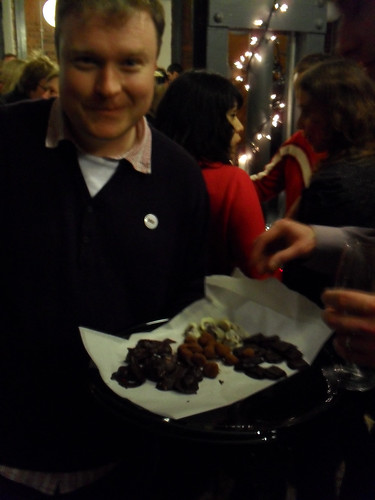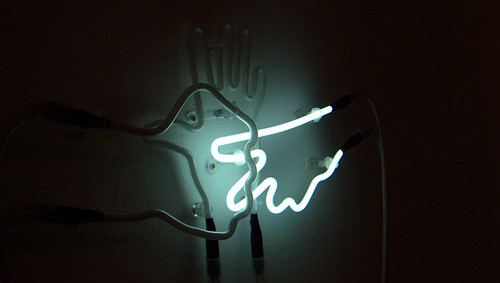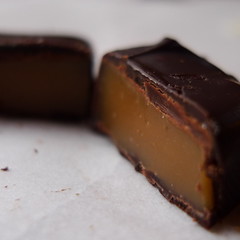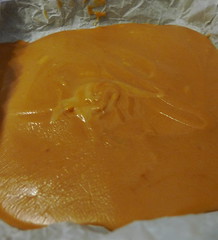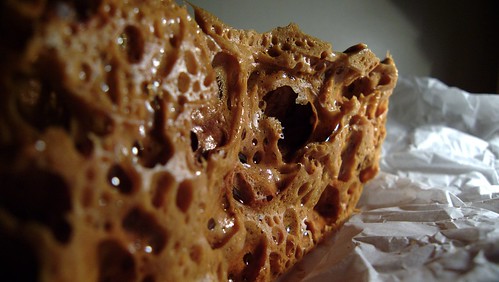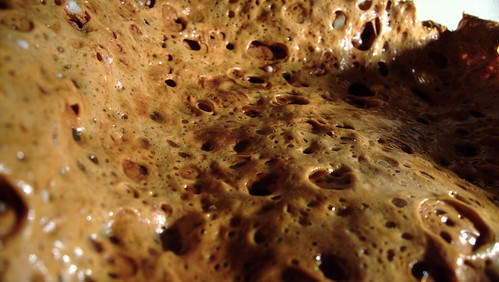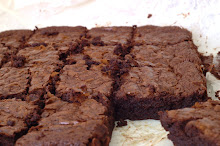 Photo by Dan Sumption, danshotme.com. Check out his work, it's excellent.
Photo by Dan Sumption, danshotme.com. Check out his work, it's excellent.Part 1 of my #IntNorth experience is
here.
My talk (slideshow now available on
Google Docs) was about Cake, and just how awesome it is.
Feedback? Well @chrismurray0 tweeted about it and @irkafirka
immortalised that tweet. I was described as "Delia Smith meets Johnny Ball" (which may go on a tshirt) and there were lots of lovely comments on the #intNorth hashtag. The official scorers were kind, too (Simon: "Mike is bobbing around in front of giant projections of cake like a demented weather man"). I know I blethered on a bit too fast, though, and some people didn't really get the talk. So, here is what I wanted to talk about, hopefully slightly more accessable than what I actually heard coming out of my mouth.
Also, I appreciate that this may be a bit TL;DR. Well, this was written as a 20-minute session, which I rattled through in what was probably closer to eight minutes, skipping over a lot of stuff quite lightly.
It was fun, though.
------
So, then. Cake. I just want to emphasise how important cake is; economically, sociologically, in terms of religion, history and technology. It's cruel to talk about cake when you don't have any, I know, and I'll be bombarding you with cake porn. Sorry about that.
Cake has been with us since... forever. Recently objects that are described as cakes were found in neolithic dig sites in Switzerland, and although we wouldn't describe them as being cake now, they were part of a celebratory meal, more than just your usual bread and meat. Sweetened with honey, these cakes were basically just enriched bread, risen using airborne yeast and heat. Most bread at the time would have tasted sour to us, so sweetening would have made the bread quite different to usual and hence cake as a seperate entity began to exist. During the age of Empires, like on the Greek monument shown here (slide 3), cake was sacrificed to the gods, presumably because it's cheaper and less messy than killing young ladies of a marriagable age. Or inexperienced young men, of course. Cake is still symbolically sacrificed today, too; the Chinese moon cake, for example, as well as the Christian host. Although I guess that's more of a biscuit.
So for most of history cake and bread are more or less synonymous; risen with yeasts and as yeast became more understood thanks to the baking and brewing industries around about two thousand years ago, its worth as a raising agent meant that bread gradually became more industrialised and less sour. Bakers, who were getting better quality flour thanks to milling, were looking at different ways of making cake more refined, to enhance that celebratory quality. For a very long time bakers would buy the barm, or the foam that is created during the brewing brocess. This would be skimmed off by the brewer and sold to the baker next door, who then had a lighter, airier raising agent to use in their doughs.
In Britain we do argue that bread is risen by yeast, cake by chemical raising agents or sheer bloody hard work. So things like chelsea buns (like those shown on slide 6, filled with lemon curd), pannetone, doughnuts and brioche are not cakes. By the way, Marie Antoinette never said "let them eat cake"; she may have said "let them eat brioche" but she probably never said that either as the phrase was originally written by Rousseau when Marie was very young. It was propaganda against a disliked queen, basically and unfair propaganda at that. What we can attribute to Marie was introducing the croissant to the wider world. When she moved to France she had a desire for Viennoise pastries; four bakers in Vienna made croissants, a comparatively poorly-known pastry outside the city, so she imported one of those bakers. The fashionistas of the time thought this breakfast pastry was a revelation and so the croissant became popular throughout France, and by extension, the rest of the world.
In the late 1600s someone - accounts vary - invented the egg whisk. Eggs are great; the structure and amount of protein in them means they hold bubbles really well and so you can beat bubbles into them using a wooden spoon if you have long enough. However, the whisk was an extension of bundling up twigs to beat eggs and then fishing out the broken off bits. It was possible to use something other than yeasty foam - which made cakes less dense than bread but still fairly stodgy - to make cakes rise. If you whisk eggs for long enough they form a light, airy foam which you can then add melted butter, sugar and flour to. This is known as the Genoise method and is still used in commercial kitchens today. It is a bit of a faff, though and requires plenty of time; beating eggs by hand to that stage requires a strong right arm. This (slide 9) is what happens if you don't read a recipe properly, or think you've got it right, or think you have a working oven. It's wrong. This really is a method best suited for making lots of cake in big trays in proper ovens, which is why these days we use the Victoria Sponge method at home, with chemical raising agents.
For baking powder we really only have one man to thank; Alfred Bird, an industrial chemist who married someone who was allergic to eggs and yeast. He invented custard powder that had never been near an egg, initially just for use at home; when it was accidentally served to guests he discovered a new industry, that of chemical food manufacture, and built up a company that still exists today selling custard powder that many of us have in our kitchens. Baking powder was invented so that his wife could eat bread again. Now, I love my wife dearly but this chap must have been utterly devoted to Elizabeth to invent an entirely new industry so she could have bread and custard.
Of course, baking powder revolutionised home baking. All of a sudden it was possible to make cake in reliatively small quantities and with import duties on sugar being reduced cake as we know it today started appearing more and more in tea rooms and in the homes of people who ordinarily wouldn't have had the space or money to make it themselves (and I've not even touched on oven design over the years!). As a quick aside, this phenomenon of home baking is really only common in some former parts of the Empire and Scandinavia. Even in the UK it is comparatively rare; cakes vanished during the war because of sugar rationing, and after the way industrial food manufacture took off, "convenience" being the label that sold. Prepackaged, homogeonised culture which meant that cooking food from scratch at home hit an all-time low that only started to be reversed thanks to food nuts in the 70s - thank god for Hippies - who basically made cakes not that dissimilar to the ones made by cavemen. Home baking in the UK is on the rise, but it has a long way to go, which is why I will be happy if just one of the audience who has never baked before goes home after this talk and makes a cake. So! Let's talk about making a cake.
You sort-of need all of this lot (slide 13); eggs, sugar, butter, self-raising, baking powder and vanilla. You also need baking parchment, an 8-inch tin, a decent sized mixing bowl and two spoons, one to beat the crap out of everything and one to gently turn it. An oven helps, too.
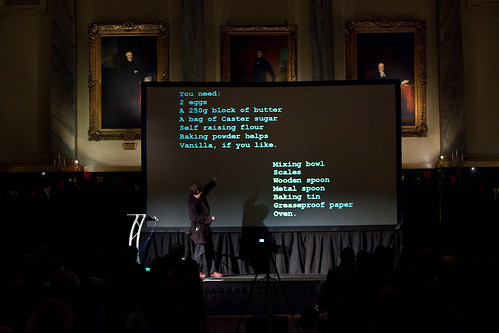 Dan Sumption, danshotme.com
Dan Sumption, danshotme.comFirst, weigh your eggs. You have no idea how much the size of an egg can vary, and if you follow a recipe blindly which says something like "two eggs, 200g flour" you could get the proportions of liquid to solid very, very wrong and you'll end up with a horrible, dense or overflowing mess. Ok, it'll taste ok but it won't look particularly good. So you weigh the eggs and then use that weight of butter, sugar and flour; if you have 100g of egg then you use 100g of butter, 100g sugar, 100g flour.
Next, cream together the butter and sugar. It is vital that you get this bit right, as a poorly creamed start will make the cake collapse, and I'll talk about why in a moment. Creaming gets everything smooth and aligned molecularly in the bowl and gets air into the mix. If you've ever eaten a sugar sandwich you'll have a decent idea of what a blob of butter and sugar tastes like, but properly creamed it tastes totally different, smoother, cleaner, lighter. Your aim at this stage is air and smoothness. Next comes adding the egg; you can add an egg at a time or beat the two eggs together in another bowl and add it a spoon at a time, beating it in so it's properly mixed in. If you add all the egg at the same time the mix will look like it's curdled; this is fixable or even ignorable but at the expense of lightness and if you can avoid it to begin with you'll end up with a better cake. You add vanilla at this stage, if you like.
Once the egg is mixed in, fold in your flour. You were told at school that you have to fold in because you've been beating in all this air and you don't want to knock it out again; this is rubbish, frankly. You fold it in because you don't want to overwork the flour which will start to form long strands of gluten in the matrix. If gluten starts forming the cake will go doughy and breadlike and again, you'll lose lightness. Mix just until the flour is properly amalgamated, and then stop.
The thing to note here is that cake is a colloid; this is something that looks like a solution and acts like a homogeonous mass, to the extent that if you left it to stand it wouldn't separate out into its component parts of its own volition, but if you were to use a small enough filter you could force it to separate. That's the intention; a smooth, consistent matrix.
If you don't cream your butter and sugar properly, when you add the egg it looks like this (slide 19), a micrograph at 100x. In the bowl it looks like it has split, like bad mayonnaise. These large blobs are fat, which will melt and cause uneven texture and may even make the cake collapse. This next slide (20) shows what properly mixed cake batter before you add the flour looks like; you see those blobs aren't there and we've got a fairly consistent matrix of bubbles. These bubbles are important. As you heat up the mix the water inside those bubbles will turn into steam and make the bubble expand. Now, at this point those bubbles will break apart fairly easily, but when you add flour (slide 21) you can see that the walls are much thicker and can take expansion for much longer. The flour is supporting the bubble matrix, and as the cake starts to dry out the matrix can be held up under its own supporting structure. This is why it is important to keep the cake in the oven for long enough to cook through, as if these bubbles cool before drying out they'll contract and make the cake collapse.
Right, the baking medium; take a length of baking parchment, scrunch it up, unscrunch and stuff it into the tin around the base. Don't bother with greasing the tin; silicon paper will cheerfully be non-stick enough to live with here. (slide 16)
You've preheated the oven, right? I have a gas oven and GM3 is fine for me, I think it's 165C or 310F, something like that. Pop it on the middle shelf and leave it for at least 35 minutes. Don't open the door, don't knock the oven, don't do anything that might reduce the heat levels inside the oven until the cake is 90% cooked. The cake, when cooked, should be making little pops and whistles, smelling biscuitty and have a nice golden top to it. Before it's doing that
don't open the oven door as it'll make the cake collapse in the way I said before. Stick a toothpick in and make sure nothing wet comes out with it, and it's done.
The lovely golden top is not caramelisation, by the way; it is a byproduct of the Maillard reaction, which involves amino acids as well as sugar. Lots of tasty chemicals are formed here, and they are what makes cake taste so nice. (slide 24)
If you do take the cake out too early then that's that; it'll collapse and there's nothing you can do about that. This (s25) is what happens, but you know what? It'll taste fine anyway, and icing covers a multitude of sins. Drizzle it in lemon juice and sugar and it'll be fine for anybody; the important thing is that you made it yourself, which always makes people smile, no matter how cynical they can be. When it comes out properly (s26) it looks like this; texture and crumb are even and look appetizing, the middle isn't sagging or undercooked and the cake holds itself up even when filled with lemon curd. Yes, again with the lemon curd; it takes two minutes to make if you're brave and I'll talk about that some other time.
Sometimes you don't need to worry about the cake collapsing; Dundee cake or Christmas cake will support its own structure because it has so much supporting flour and fat in there - a bit like laminar pastry - that it won't rise very much in the oven anyway, just dry out and let the molecular bonds form. And you don't even need to use normal sugar, sometimes; you can use good alternatives like honey or strawberry jam, which have a low moisture content and shouldn't affect the cake too much - but be careful, and don't add too much on your first outing, as it might make the cake a bit damper than you'd expect.
Finally, you know that saying, "you can't have your cake and eat it"? It's bobbins. You can have your cake and eat it, and once you have eaten it it stays with you forever, in your memories and as parts of you. Enjoy the cake, embrace it, and remember that baking is really just a science lesson for hungry people. Thank you.
---------------
There's a credits slide which is woefully underpopulated, too. Sorry about that. Some of the script is lifted from my articles at
Tea and Cake and elsewhere.
